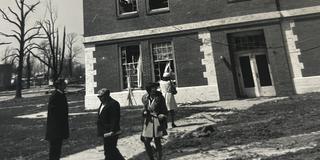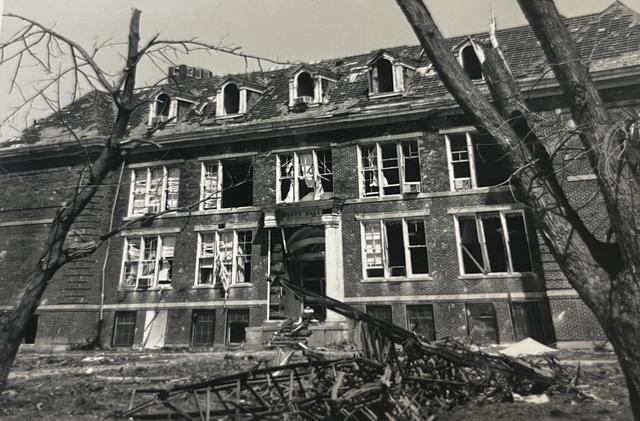
Marauder Strong: Central State University perseveres after devastating tornado

Above: Survivors of the 1974 tornado roam outside an older classroom building that was mostly structurally intact, but had broken windows and much water damage. Photo courtesy of the Greene County Historical Society.
Spirit of resilience continues today
The story of Central State University is one of perseverance and resilience, embodied by our students, faculty, staff, and alumni. Arguably, no event demonstrates the indomitable spirit of Central State better than the rebuilding after devastating tornadoes hit Xenia and Wilberforce on April 3, 1974.
The tornado was no ordinary weather event — it was part of an infamous Super Outbreak that affected 13 states across the eastern United States, leaving in its wake a trail of destruction and devastation, according to the National Weather Service.
In total, 148 tornadoes were documented from this event, causing 335 deaths and over 6,000 injuries, the NWS reports. Ohio was one of the hardest hit areas, with 159 deaths and over 4,000 injuries reported in the Ohio Valley region alone. Two violent F5 tornadoes wreaked havoc in Xenia and Sayler Park, a western suburb of Cincinnati, with the former being one of the deadliest with 34 deaths. The Xenia tornado is one of the costliest U.S. tornadoes on record, with damages totaling approximately $250 million in 1974.
Tragically, four people associated with Central State lost their lives that day, three of whom were driving in the surrounding area at the time. They included one student, Laura Lee (Baber) Hull, age 19, who passed away on U.S. 42 when the tornado struck the car she was driving from Central State to her home in Xenia.
Three staff members also died — groundskeeper Ralph E. Smith, credit union director Evelyn V. (Howard) Rockhold, and postmaster Oscar T. Robinson. Rockhold passed away at Springfield Community Hospitals from injuries received during the storm. Smith was driving on Stevenson Road at the time, while Robinson died when the tornado struck the post office in Wilberforce.
Despite all this, the people of Central State University refused to be defeated.
Their unwavering commitment to one another and to their community saw them through this difficult time, and their story of resilience continues to inspire to this day.
Regional, state, national, and international news organizations all reported on the tornado in the days and years since. Reports indicated that around 80% of the campus was destroyed, causing millions of dollars in damage. An article in the Daily Kent Stater, Kent State University’s newspaper, reported neighboring Wilberforce University was nearly unscathed but also closed in the wake of the devastation.
However, Central State refused to let this setback bring it down and immediately started planning to reopen within a week of the catastrophe.
The aftermath of the tragedy was chaotic and overwhelming. The campus did not receive assistance from outside Wilberforce for about five hours, leaving the students, faculty, and staff to fend for themselves, as debris reportedly kept emergency vehicles from responding. However, the community came together swiftly. Anison J. Colbert, director of the Xenia McLin Funeral Home, was one of the first to arrive at the campus around 9 p.m. to offer his assistance.

“We first tried to go out at about 7:30 p.m., but there was so much debris everywhere we had to turn around,” Colbert said in a Dayton Daily News interview. He then notified the then-Xenia sheriff’s office that the campus had been hit and needed help.
The campus was left without water and electricity, the DDN reported.
The April 6 edition of the Dayton Daily News featured an interview with then-Ohio Gov. John J. Gilligan in an article titled “Gilligan: CSU Won’t Close.”
“(Gilligan) promised students and faculty Thursday afternoon that Central State university [sic] will not be ‘wiped off the map’ by Wednesday’s tornado damage,” the article states.
CSU’s President, Lionell H. Newsom, met with other area university presidents to seek their support. “In the meantime, Newsom has asked all the students at the predominantly black [sic] university to go home until classes resume. He promised the senior class that it will graduate June 9 on schedule.”
The promise was kept, and students graduated on time.
The article describes students as “concerned and shaken,” stating they “had been told earlier that the university might close for the remainder of the year.” Buses were called to transport students from Wilberforce to Columbus, Cleveland, Cincinnati, and Toledo.
“‘IT JUST [sic] is not going to happen (closing),’ Gilligan shouted to cheers and applause,” the article states.

Then-President Nixon had declared six counties in southwestern Ohio, including Greene County, as disaster areas qualifying for federal aid. The president of the Dayton Miami Valley Consortium of Colleges and Universities, Dr. Jeptha Carrel, said there was ample interest among its members to help Central State. The University of Dayton offered to reopen its West Dayton campus, with dorm space for 400 students, a cafeteria, classrooms and a large greenspace. It had formerly been unoccupied during the winter months.
Wright State University offered students the use of its library after the CSU Library was heavily damaged. Some students also attended their CSU classes at Wright State.
Many students opted to stay on campus to help with cleanup efforts.
“We’re determined we’re going to go to school there even if there is only half a campus and it is pretty raggedy looking,” student Mike Watkins said.
Students were housed at area hotels and motels, offering free lodging for several days.
“We’re not going home,” said Mark Townsell, another student. “There’s a job to be done over there and we feel we’re more needed here.”
To commemorate the University's resilience and determination, Central State will host a memorial service from 4:15-4:45 p.m. on April 3 at Walter G. Sellers Alumni Tower/William Galloway Hall, which is one of the few structures that stood intact after the storm. However, much of the building was destroyed, making it a poignant example of Central State's resiliency.
Learn more about this and other events commemorating the anniversary.


